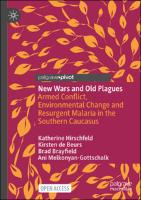New Wars and Old Plagues
Armed Conflict, Environmental Change and Resurgent Malaria in the Southern Caucasus
| dc.contributor.author | Hirschfeld, Katherine | |
| dc.contributor.author | de Beurs, Kirsten | |
| dc.contributor.author | Brayfield, Brad | |
| dc.contributor.author | Melkonyan-Gottschalk, Ani | |
| dc.date.accessioned | 2023-07-14T15:43:07Z | |
| dc.date.available | 2023-07-14T15:43:07Z | |
| dc.date.issued | 2023 | |
| dc.identifier | ONIX_20230714_9783031311437_35 | |
| dc.identifier.uri | https://library.oapen.org/handle/20.500.12657/63955 | |
| dc.description.abstract | This Open Access book uses Mary Kaldor’s concept of “New Wars” to explore how ethnic conflict reshaped the social and environmental landscape of the Southern Caucuses following the collapse of the Soviet Union. It relies on remote sensing data and qualitative historical research to explore how armed conflict between non-state actors generated the region’s largest epidemic of P. vivax malaria since the 1960s. This book is an important addition to the literature on the Karabakh conflict and conflict studies more broadly because the infectious disease outbreaks associated with warfare often kill more people than the armed conflicts themselves. Warfare itself has also changed dramatically since the collapse of the USSR, and the Karabakh conflict provides an excellent case study of the way “New Wars” transform the natural and social environment to facilitate outbreaks of preventable disease. This extended case study will be useful to researchers from a variety of academic disciplines, including medical anthropology, geography, conflict studies, disease ecology, global health and public health. It also reveals the fragility of twentieth century malaria control in temperate regions and will assist in predictive modeling for future outbreaks. | |
| dc.language | English | |
| dc.subject.classification | thema EDItEUR::P Mathematics and Science::PS Biology, life sciences::PSX Human biology | en_US |
| dc.subject.classification | thema EDItEUR::J Society and Social Sciences::JH Sociology and anthropology::JHM Anthropology | en_US |
| dc.subject.classification | thema EDItEUR::M Medicine and Nursing::MB Medicine: general issues::MBN Public health and preventive medicine | en_US |
| dc.subject.classification | thema EDItEUR::J Society and Social Sciences::JP Politics and government::JPS International relations | en_US |
| dc.subject.classification | thema EDItEUR::R Earth Sciences, Geography, Environment, Planning::RG Geography::RGC Human geography | en_US |
| dc.subject.classification | thema EDItEUR::N History and Archaeology::NH History::NHB General and world history | en_US |
| dc.subject.other | Armed conflict | |
| dc.subject.other | Malaria | |
| dc.subject.other | Medical anthropology | |
| dc.subject.other | Emerging infectious diseases | |
| dc.subject.other | Disease ecology | |
| dc.subject.other | Karabakh | |
| dc.subject.other | Caucasus | |
| dc.subject.other | Remote sensing | |
| dc.subject.other | Medical geography | |
| dc.subject.other | Post-Soviet history | |
| dc.subject.other | Warfare | |
| dc.subject.other | Non-state actors | |
| dc.title | New Wars and Old Plagues | |
| dc.title.alternative | Armed Conflict, Environmental Change and Resurgent Malaria in the Southern Caucasus | |
| dc.type | book | |
| oapen.identifier.doi | 10.1007/978-3-031-31143-7 | |
| oapen.relation.isPublishedBy | 6c6992af-b843-4f46-859c-f6e9998e40d5 | |
| oapen.relation.isFundedBy | e8025389-9887-46a8-bb52-e47e56b7308e | |
| oapen.relation.isbn | 9783031311437 | |
| oapen.relation.isbn | 9783031311420 | |
| oapen.imprint | Palgrave Macmillan | |
| oapen.pages | 113 | |
| oapen.place.publication | Cham | |
| oapen.grant.number | [...] |

